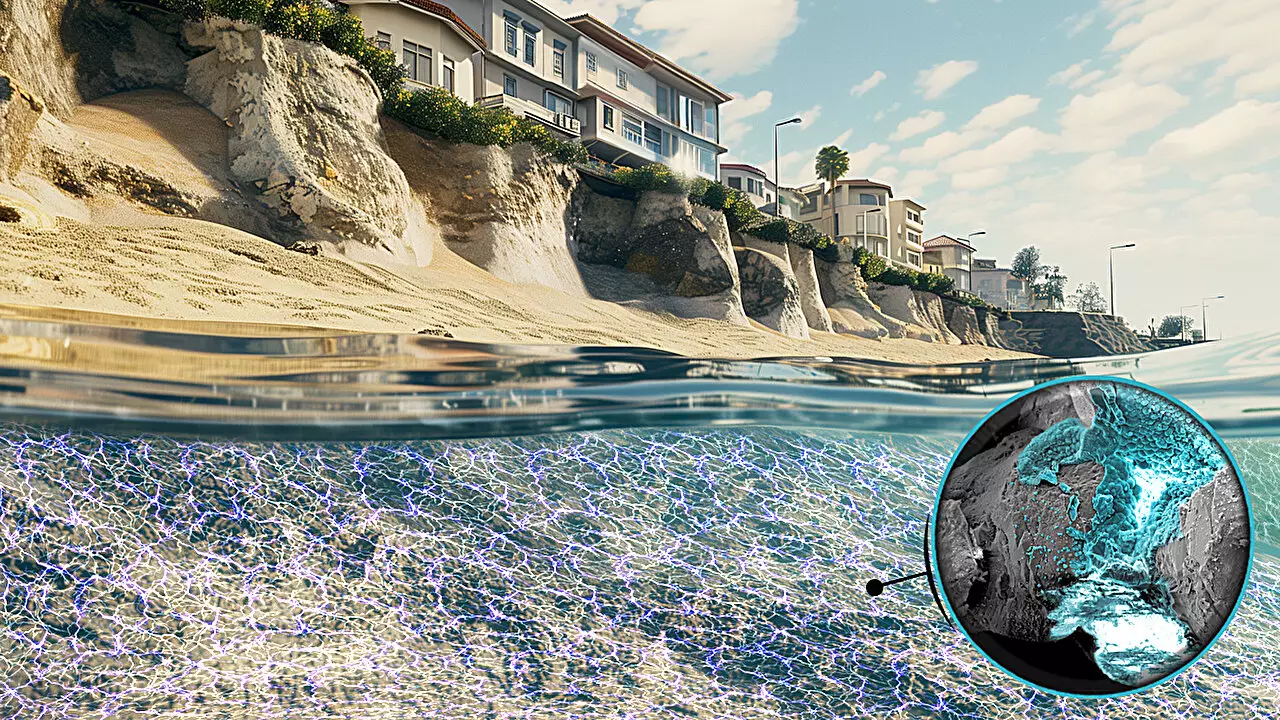Coastal erosion poses a significant threat to shores worldwide, exacerbated by the effects of climate change and rising sea levels. As natural land formations deteriorate, vital ecosystems and human infrastructure face peril. Traditional methods of combating erosion—such as building sea walls or injecting binding agents—have proved excessively costly and often ineffective. However, a recent breakthrough by researchers at Northwestern University is offering a novel technique that could fundamentally change how we approach this growing environmental challenge.
Inspired by the natural processes of marine organisms such as clams and mussels, researchers at Northwestern have discovered that applying a mild electrical current to marine sediments can create a durable form of cement using sea minerals. The study, led by Alessandro Rotta Loria, highlights a method where seawater is transformed into solidified structures without significant ecological disruption. This innovative approach eschews conventional cement in favor of harnessing the natural minerals found in seawater, which serve as an eco-friendly binder for sand grains.
Through rigorous laboratory experiments, the team demonstrated that electrical currents can stimulate chemical reactions that solidify marine sand into a rock-like structure. The treatment process requires only modest energy—approximately 2 to 4 volts—to initiate these beneficial reactions. As a result, this transformative approach not only simplifies the process of reinforcing coastal landscapes but also positions itself as a sustainable alternative for long-term shoreline protection.
So how exactly does this method work? The applied electrical current influences the chemical dynamics within the surrounding seawater. It triggers the deposition of minerals such as calcium carbonate, commonly used by marine organisms like mollusks for building protective shells. With voltages on the higher end, magnesium hydroxide can also be formed, providing additional binding capabilities. These resultant minerals act as a natural adhesive, bonding sand particles together into a cohesive mass capable of withstanding environmental stresses.
The results from laboratory tests show promise: after exposure to electrical stimulation, treated sand displays properties akin to solid rock rather than loose grains. When visualizing the process, think of a vibrant coral reef. Just as coral structures form strong protective habitats, this technique has the potential to create resilient shorelines resistant to the ravages of erosion.
Implementing this approach has several advantages, particularly regarding cost-effectiveness. According to Rotta Loria’s estimates, the expense involved in electrically cementing marine sediments could range from $3 to $6 per cubic meter. In stark contrast, traditional cement infusion methods can inflate costs to as much as $70 per cubic meter. These financial savings could be transformative for communities facing erosion, allowing them to allocate resources more effectively while ensuring the longevity of their coastlines.
Moreover, the low-voltage electricity employed during the process is not harmful to sea life. Studies from previous efforts indicate that similar electrical methods have successfully enhanced undersea structures and coral ecosystems without impacting marine organisms adversely. Hence, this research offers a dual promise: environmental restoration through technological innovation.
This pioneering technique also holds potential beyond simply reinforcing beaches. The electrically cemented sand could be used to stabilize problematic soil slopes, enhance the durability of existing coastal structures, and even restore damaged infrastructure without the extensive costs of complete reconstruction.
In Rotta Loria’s vision, the applications seem limitless. From strengthening the seabed below critical barriers to fortifying sand dunes, this methodology could revolutionize coastal engineering practices. Additionally, as researchers move forward with testing their technique in real-world beach settings, the environmental implications of creating resilient coastlines continuously unfold.
With over 40% of the global population residing in coastal areas, the urgency to address erosion and its associated hazards cannot be overstated. Northwestern University’s innovative research demonstrates that combining natural processes with new technology can lead to sustainable solutions for environmental challenges. By shifting the paradigm in coastal protection, this electrical cementing technique exemplifies how humanity can work in harmony with nature—an essential step in strengthening our vulnerable coastlines against the relentless tide of climate change. The coming years will be crucial in assessing this technology’s real-world applications, offering hope for a resilient future.

